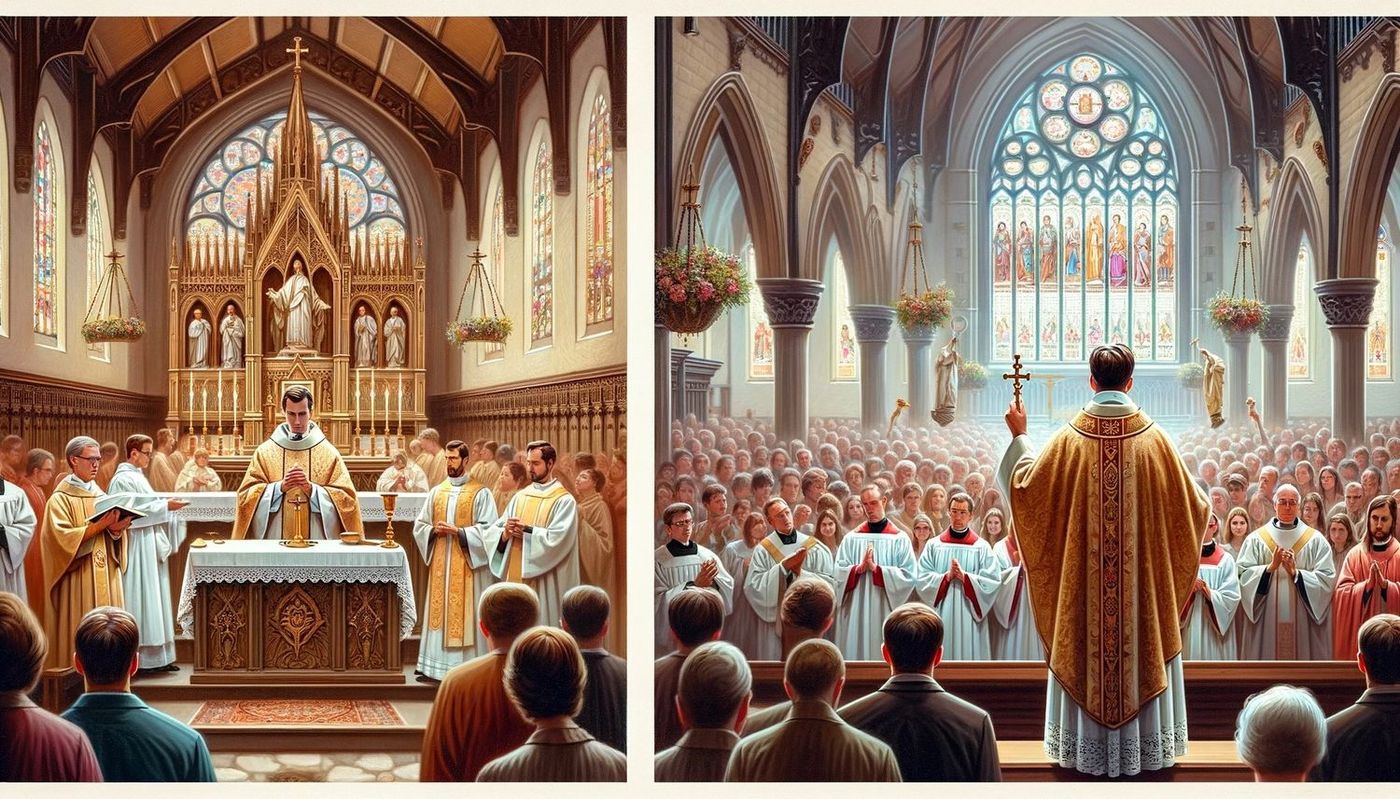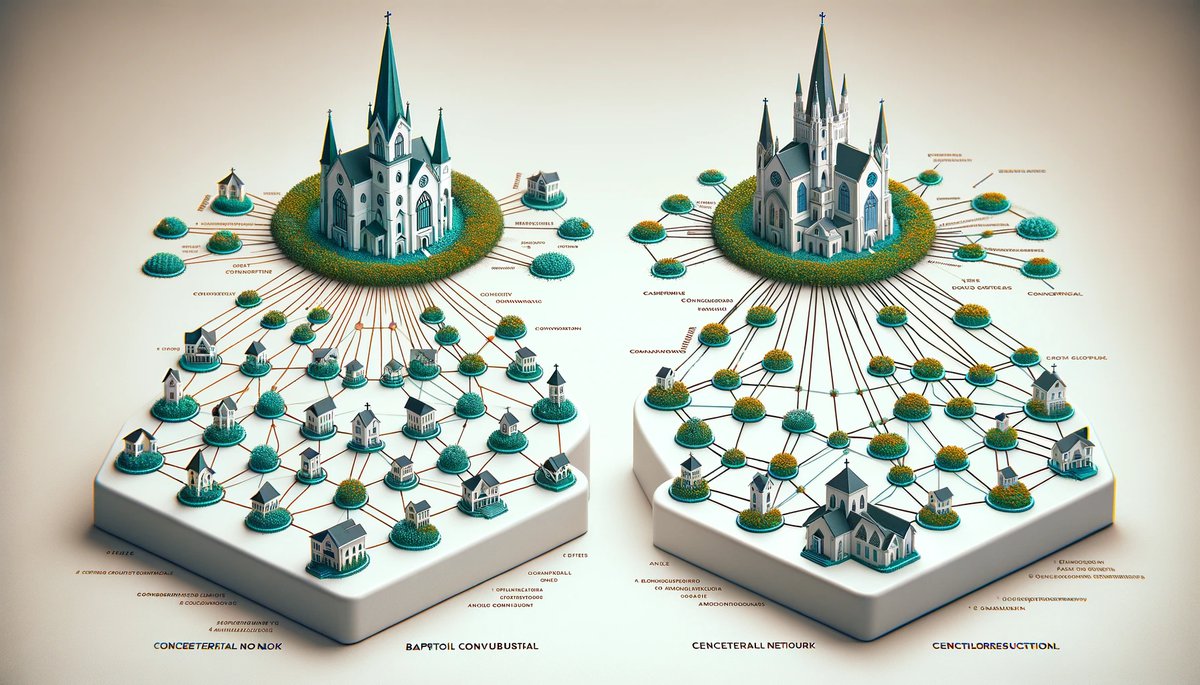Home>Theology and Spirituality>What Is The Difference Between Catholicism And Presbyterianism


Theology and Spirituality
What Is The Difference Between Catholicism And Presbyterianism
Published: February 17, 2024
Peter Smith, Editorial Director at Christian.net, combines deep insights into faith, politics, and culture to lead content creation that resonates widely. Awarded for his contributions to religious discourse, he previously headed a major organization for religious communicators, enhancing dialogue on faith's societal impacts.
Discover the key distinctions between Catholicism and Presbyterianism in terms of theology and spirituality. Explore their beliefs and practices to gain a deeper understanding.
(Many of the links in this article redirect to a specific reviewed product. Your purchase of these products through affiliate links helps to generate commission for Christian.net, at no extra cost. Learn more)
Table of Contents
Introduction
Catholicism and Presbyterianism are two distinct branches of Christianity, each with its own rich history, beliefs, and practices. While both traditions are rooted in the teachings of Jesus Christ, they have evolved separately over the centuries, leading to differences in theology, church structure, and worship. Understanding the disparities between Catholicism and Presbyterianism can provide valuable insights into the diverse tapestry of Christian faith.
The exploration of these differences is not about establishing superiority or inferiority; rather, it is an opportunity to appreciate the unique expressions of faith that have emerged within the Christian tradition. By delving into the distinct characteristics of Catholicism and Presbyterianism, we can gain a deeper understanding of the multifaceted nature of Christianity and the various ways in which individuals and communities connect with their spiritual beliefs.
In the following sections, we will embark on a comparative journey, examining the core tenets, rituals, and organizational structures that distinguish Catholicism from Presbyterianism. By shedding light on these differences, we aim to foster a greater appreciation for the diversity of Christian thought and practice, ultimately enriching our collective understanding of the multifaceted tapestry of Christian faith.
Beliefs and Practices
Catholicism and Presbyterianism encompass distinct sets of beliefs and practices that shape the spiritual lives of their adherents. Understanding these differences is essential in comprehending the theological and doctrinal variations between the two traditions.
Catholicism
Catholicism, with its roots tracing back to the early Christian Church, upholds a rich tapestry of beliefs and practices. Central to Catholic faith is the veneration of the Holy Trinity—Father, Son, and Holy Spirit—as well as the veneration of Mary, the mother of Jesus, and the communion of saints. Catholics believe in the authority of the Pope, who is regarded as the successor of Saint Peter and the earthly head of the Church. The doctrine of transubstantiation, which teaches that the bread and wine used in the Eucharist become the actual body and blood of Christ, is a fundamental tenet of Catholic faith. Additionally, the sacraments, including baptism, confirmation, confession, marriage, holy orders, and the anointing of the sick, hold significant importance in the Catholic tradition.
Presbyterianism
In contrast, Presbyterianism, a branch of Reformed Protestantism, emphasizes the sovereignty of God and the authority of the Bible. Presbyterians adhere to the concept of predestination, which asserts that God has preordained the salvation of some individuals. The governance of the Presbyterian Church is characterized by a system of elders, or presbyters, who hold authority within the church. Unlike Catholicism, Presbyterian worship is marked by simplicity, with an emphasis on preaching and the singing of psalms and hymns. The sacraments, including baptism and the Lord's Supper, are central to Presbyterian worship and are celebrated with reverence and solemnity.
The divergent beliefs and practices of Catholicism and Presbyterianism reflect the historical and theological developments that have shaped these traditions. While Catholicism places emphasis on the veneration of saints, the authority of the Pope, and the sacramental nature of the Church, Presbyterianism highlights the sovereignty of God, the authority of Scripture, and a more simplified approach to worship and governance.
Understanding these distinctions illuminates the diverse expressions of Christian faith and underscores the multifaceted nature of spirituality within the broader Christian tradition. By recognizing and appreciating these differences, we can cultivate a deeper understanding of the rich tapestry of beliefs and practices that characterize Catholicism and Presbyterianism.
Church Hierarchy
Catholicism
In Catholicism, the church hierarchy is characterized by a centralized structure with the Pope at its apex. The Pope, also known as the Bishop of Rome, is regarded as the successor of Saint Peter, to whom Jesus entrusted the leadership of the early Christian Church. As the supreme pontiff, the Pope holds the highest authority in matters of faith and morals for Catholics worldwide. Beneath the Pope are the College of Cardinals, who serve as advisors and elect the new Pope upon the vacancy of the position. The next level of the hierarchy comprises bishops, who oversee dioceses and are responsible for the spiritual well-being of the faithful within their respective regions. Additionally, priests, who serve as spiritual leaders within local parishes, and deacons, who assist in pastoral and charitable ministries, form essential components of the Catholic Church's hierarchical structure.
Presbyterianism
In contrast, Presbyterianism follows a more decentralized model of church governance. The church hierarchy is characterized by a system of elders, or presbyters, who collectively form the governing body known as the presbytery. This collective leadership model reflects the Presbyterian emphasis on shared decision-making and the avoidance of hierarchical distinctions among clergy. Each presbytery is further connected to a broader regional body known as the synod, which provides support and oversight to the individual presbyteries within its jurisdiction. At the national level, the General Assembly serves as the highest governing body, bringing together representatives from presbyteries and synods to address theological, administrative, and ecclesiastical matters.
The contrasting structures of church hierarchy in Catholicism and Presbyterianism reflect differing approaches to leadership, authority, and decision-making within the respective traditions. While Catholicism embraces a centralized model with the Pope as the ultimate authority, Presbyterianism embodies a more egalitarian and collaborative approach to church governance, emphasizing the collective wisdom and discernment of elders and presbyteries. Understanding these distinctions illuminates the diverse organizational frameworks that underpin the spiritual and administrative dimensions of Catholic and Presbyterian faith communities.
Sacraments
Catholicism
In Catholicism, the sacraments hold profound significance as sacred rituals that convey the grace of God to the faithful. The Catholic Church recognizes seven sacraments, each serving as a visible sign of God's presence and a means of spiritual nourishment for believers. These sacraments include Baptism, Confirmation, Eucharist, Penance (Reconciliation), Anointing of the Sick, Holy Orders, and Matrimony.
Baptism marks the initiation into the Christian faith, cleansing the individual of original sin and initiating them into the community of believers. Confirmation, often performed during adolescence, strengthens the bond with the Church and bestows the gifts of the Holy Spirit. The Eucharist, also known as Holy Communion, is the central sacrament of Catholic worship, where the faithful partake in the body and blood of Christ. Penance, or Reconciliation, offers the opportunity for repentance and forgiveness of sins through confession to a priest. The Anointing of the Sick provides spiritual healing and comfort to those facing illness or frailty. Holy Orders ordains individuals into the priesthood, while Matrimony sanctifies the union of two individuals in marriage.
Presbyterianism
In Presbyterianism, the sacraments are viewed as symbolic acts that signify the spiritual truths of the Christian faith. The tradition recognizes two sacraments: Baptism and the Lord's Supper (Communion). Baptism, often administered to infants as a sign of God's covenant with the individual and their inclusion in the community of faith, symbolizes the washing away of sin and the new birth in Christ. The Lord's Supper, celebrated with bread and wine, commemorates the sacrificial death of Jesus Christ and the spiritual nourishment received through partaking in the elements.
The Presbyterian approach to the sacraments emphasizes their symbolic nature, highlighting their role as visible signs of God's grace and the spiritual realities of the Christian journey. While the Catholic understanding of the sacraments emphasizes their efficacy as channels of divine grace, Presbyterianism underscores their symbolic and instructional significance within the context of worship and spiritual formation.
The divergent perspectives on the sacraments in Catholicism and Presbyterianism reflect the theological nuances and doctrinal emphases that distinguish these traditions. Understanding these differences provides valuable insights into the diverse expressions of Christian faith and the varying interpretations of the sacramental life within the broader Christian tradition.
Worship and Liturgy
Catholicism
In Catholicism, worship and liturgy play a central role in the spiritual life of believers. The celebration of the Eucharist, also known as the Mass, stands as the pinnacle of Catholic worship. The Mass is characterized by its rich symbolism, structured order, and the participation of the faithful in the reenactment of Christ's sacrifice. The liturgical calendar, which follows the seasons of Advent, Christmas, Lent, Easter, and Ordinary Time, guides the rhythm of Catholic worship, providing a framework for commemorating key events in the life of Christ and the Church.
Catholic liturgy is marked by its reverence for tradition, incorporating sacred rituals, prayers, and hymns that have been passed down through centuries. The use of incense, candles, and sacred vestments adds to the sensory richness of the liturgical experience, creating a sacred atmosphere that invites worshippers to engage with the divine mysteries.
Presbyterianism
In Presbyterian worship, simplicity and solemnity are key characteristics that shape the liturgical expression of faith. The focus is on the preaching of the Word, with sermons occupying a central place in Presbyterian worship services. Hymn singing, often accompanied by organ music, is a cherished aspect of Presbyterian liturgy, with congregational participation playing a vital role in the musical worship experience.
Presbyterian worship is guided by the Directory for the Public Worship of God, which outlines the principles and elements of worship within the tradition. The observance of sacraments, particularly Baptism and the Lord's Supper, is integral to Presbyterian liturgical practice, with an emphasis on their symbolic and instructional significance.
Contrasting Approaches
The contrasting approaches to worship and liturgy in Catholicism and Presbyterianism reflect differing emphases on tradition, symbolism, and congregational participation. While Catholic liturgy embraces a more elaborate and ritualistic form of worship, Presbyterian worship emphasizes simplicity and the centrality of preaching and congregational engagement.
Understanding these differences provides valuable insights into the diverse ways in which Christian communities express their devotion and connect with the sacred. The distinct styles of worship and liturgy in Catholicism and Presbyterianism contribute to the rich tapestry of Christian traditions, offering worshippers varied avenues for encountering the divine and nurturing their spiritual lives.
Views on Salvation
Catholicism and Presbyterianism hold distinct perspectives on the concept of salvation, reflecting their theological differences and doctrinal emphases. These views shape the understanding of how individuals are reconciled with God and attain eternal life, serving as foundational elements of each tradition's belief system.
In Catholicism, salvation is viewed as a cooperative endeavor between divine grace and human response. Central to Catholic theology is the concept of justification, which entails the process of being made righteous in the sight of God. The Catholic Church teaches that salvation is attained through faith, participation in the sacraments, and the pursuit of good works inspired by God's grace. The sacraments, particularly Baptism and the Eucharist, are regarded as instrumental in the bestowal of divine grace, while acts of charity and moral living are seen as essential expressions of faith. The Catholic understanding of salvation encompasses the notion of sanctification, wherein believers are called to grow in holiness and strive for spiritual perfection through the grace of God.
In contrast, Presbyterianism emphasizes the sovereignty of God in the salvation of individuals. Rooted in the Reformed tradition, Presbyterian theology espouses the concept of predestination, which asserts that God, in His divine will, has predetermined the salvation of certain individuals. This doctrine, often associated with the teachings of John Calvin, underscores the belief that God's grace alone is the decisive factor in the salvation of believers. While Presbyterianism affirms the importance of faith and the transformative work of the Holy Spirit in the lives of believers, the tradition places primary emphasis on God's sovereign election and the assurance of salvation for those chosen by God.
The divergent views on salvation in Catholicism and Presbyterianism reflect the theological nuances and doctrinal emphases that distinguish these traditions. While Catholicism emphasizes the cooperative relationship between divine grace and human response in the pursuit of salvation, Presbyterianism underscores the sovereignty of God in the election and redemption of individuals.
Understanding these differing perspectives enriches our appreciation of the multifaceted nature of Christian faith and the diverse ways in which believers understand and experience the profound mystery of salvation. These contrasting views on salvation contribute to the theological richness of the Christian tradition, offering distinct lenses through which individuals and communities engage with the profound questions of human destiny and divine grace.
Conclusion
In conclusion, the comparison of Catholicism and Presbyterianism reveals the rich tapestry of beliefs, practices, and organizational structures that distinguish these two branches of Christianity. The exploration of their differences provides valuable insights into the diverse expressions of Christian faith and the theological nuances that have shaped these traditions over time.
Catholicism, with its emphasis on the veneration of saints, the authority of the Pope, and the sacramental nature of the Church, reflects a deep reverence for tradition, ritual, and the communal aspects of faith. The centrality of the Eucharist, the veneration of Mary, and the sacramental life underscore the sacramental richness and spiritual depth of Catholic belief and practice.
On the other hand, Presbyterianism, rooted in the Reformed tradition, embodies a more simplified approach to worship, governance, and theological interpretation. The emphasis on the sovereignty of God, the authority of Scripture, and a collective model of church governance highlights the distinctive theological emphases and ecclesiastical structures that define Presbyterian faith communities.
The contrasting perspectives on salvation, church hierarchy, sacraments, worship, and liturgy underscore the diverse theological landscapes within the broader Christian tradition. While Catholicism and Presbyterianism diverge on key doctrinal and ecclesiastical elements, both traditions bear witness to the enduring vitality and adaptability of Christian faith in diverse cultural and historical contexts.
By recognizing and appreciating these differences, we gain a deeper understanding of the multifaceted nature of Christian belief and practice. The theological richness and diversity within Christianity invite us to embrace a spirit of dialogue, mutual respect, and a shared commitment to the pursuit of spiritual truth and communal flourishing.
Ultimately, the comparison of Catholicism and Presbyterianism serves as a reminder of the enduring vitality and adaptability of Christian faith, inviting us to engage with the diverse expressions of spirituality and to cultivate a deeper appreciation for the rich tapestry of beliefs and practices that characterize the Christian tradition.












